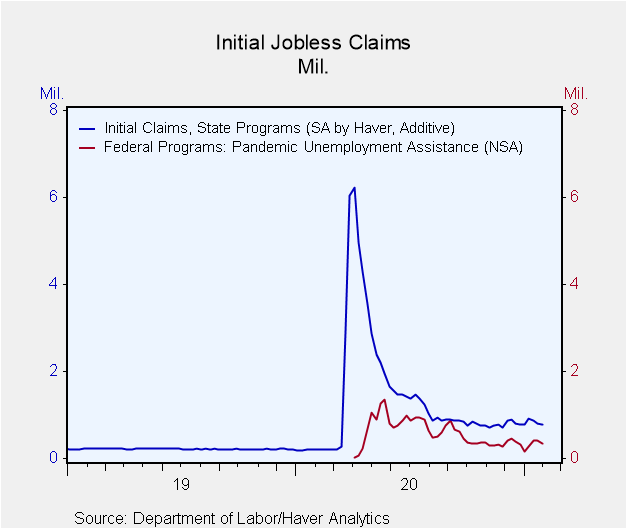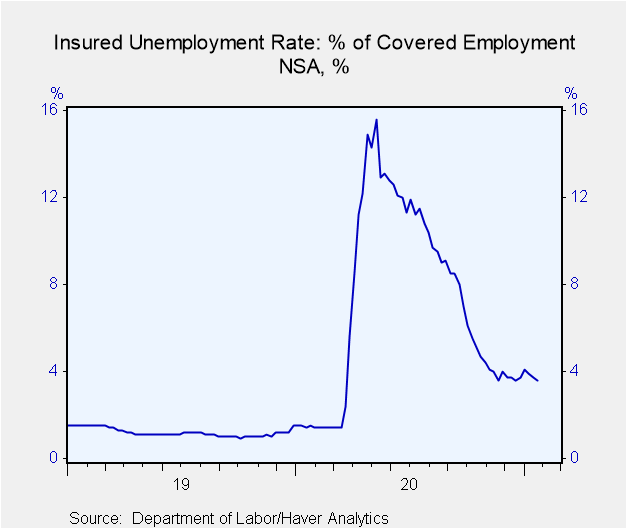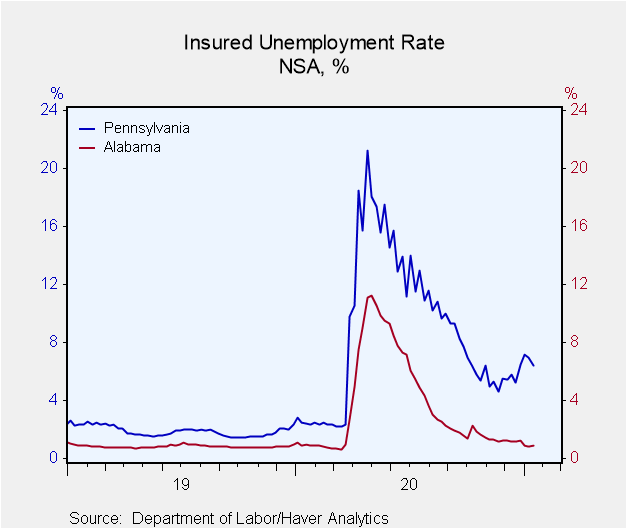 Global| Feb 04 2021
Global| Feb 04 2021U.S. Initial Jobless Claims Maintain Recent Range, but Do Show a Third Weekly Decline
Summary
• State initial claims fall 33,000; PUA claims have bigger decline of 54,678. • Continuing claims decrease 193,000; prior week revised modestly higher but still declines. • Insured jobless rate 3.2%, lowest since March 21, when [...]
• State initial claims fall 33,000; PUA claims have bigger decline of 54,678.
• Continuing claims decrease 193,000; prior week revised modestly higher but still declines.
• Insured jobless rate 3.2%, lowest since March 21, when pandemic started its impact.
Initial claims for unemployment insurance decreased by 33,000 to 779,000 in the week ended January 30. The January 23rd week saw 812,000, reflecting a downward revision from 847,000 reported last week. The January 30 decrease was the third consecutive decline in initial claims and maintained a fairly steady range that has prevailed since the end of last August. The latest week was moderately lower than the Action Economics Forecast Survey forecast of 840,000.
Initial claims for the federal Pandemic Unemployment Assistance (PUA) program were 348,912. This represents a decline of 54,678 from the January 23rd week, which was revised to 403,590 from the initially reported 426,856. The PUA program covers individuals such as the self-employed who are not included in regular state unemployment insurance. Note that the brief history of this program, which started April 4, 2020, means these data and other COVID-related series are not seasonally adjusted.
Continuing claims for regular state unemployment insurance decreased 193,000 in the week ended January 23 to 4.592 million. The prior week was revised up slightly to 4.785 million from 4.771 million initially reported. Continuing PUA claims, which are lagged an additional week and not seasonally adjusted, decreased 125,969 to 7.218 million, thus stabilizing after the previous week's 1.6 million surge to 7.344 million. Similarly, the Pandemic Emergency Unemployment Compensation (PEUC) claims fell back 289,910 to 3.603 million in the January 16 week after the prior week's 866,056 surge. This program covers people who were unemployed before COVID but exhausted their state benefits and are now eligible to receive benefits through March 14, 2021.
The total number of all state, federal and PUA and PEUC continuing claims decreased 486,405 in the January 16 week to 17.836 million. That follows an increase in this grand total of 2.333 million in the January 9 week. This grand total is not seasonally adjusted, so as we speculated last week, that prior week's surge could have simply reflected a return to more normal schedules after the holiday season. Thus, the latest decrease might simply be a calendar-related stabilization and not necessarily reflect an improving economy.
At the same time, the seasonally adjusted state insured rate of unemployment decreased to 3.2% in the week ended January 23, down from 3.4% in the week ended January 16. The latest week again achieved a new low since the pandemic impact hit in late March.
The state insured rates of unemployment – which do not include the special federal programs – continued to show wide variation. In the week ended January 16, Alabama yet again had the lowest rate at 0.877%. Pennsylvania had the highest rate at 6.43%. The rate in Kansas, which had been the highest, fell back from 7.73% in the January 9 week to 5.70% and was the fifth highest among the states. Among the larger states in the January 16 week, Florida had a rate of 1.83% and Texas had 2.82%, while California had 4.82% New York 4.88% and Illinois 5.74%. These state rates are not seasonally adjusted.
As we continue to point out, the Labor Department changed its seasonal adjustment methodology back in August from multiplicative to additive. They did not restate the earlier data, so there is a break in the series in late August. Though the current comparison to early September is valid, comparisons with figures before August 22 are not. Haver Analytics has calculated methodologically consistent seasonally adjusted claims series dating back to 1979. This series matches the Department of Labor seasonally adjusted series since their change in methodology. For more details, please see the September 3 commentary on jobless claims.
Data on weekly unemployment claims going back to 1967 are contained in Haver's WEEKLY database, and they are summarized monthly in USECON. Data for individual states are in REGIONW. The expectations figure is from the Action Economics Forecast Survey, carried in the AS1REPNA database.
| Unemployment Insurance (SA, 000s) | 01/30/21 | 01/23/21 | 01/16/21 | Y/Y % | 2020 | 2019 | 2018 |
|---|---|---|---|---|---|---|---|
| Initial Claims | 779 | 812 | 875 | 288 | 1,450 | 218 | 221 |
| Initial Claims (NSA) | 816 | 840 | 936 | 263 | 1,367 | 218 | 221 |
| Initial Claims Pandemic Unemployment Assistance (NSA) | 349 | 404 | 420 | -- | -- | -- | -- |
| Continuing Claims | -- | 4,592 | 4,785 | 162 | 10,664 | 1,701 | 1,756 |
| Continuing Claims (NSA) | -- | 5,095 | 5,222 | 137 | 10,358 | 1,704 | 1,763 |
| Continuing Claims Pandemic Unemployment Assistance (NSA) | -- | -- | 7,218 | -- | -- | -- | -- |
| Insured Unemployment Rate (%) | -- | 3.2 | 3.4 |
1.2 |
7.3 | 1.2 | 1.2 |
Carol Stone, CBE
AuthorMore in Author Profile »Carol Stone, CBE came to Haver Analytics in 2003 following more than 35 years as a financial market economist at major Wall Street financial institutions, most especially Merrill Lynch and Nomura Securities. She had broad experience in analysis and forecasting of flow-of-funds accounts, the federal budget and Federal Reserve operations. At Nomura Securities, among other duties, she developed various indicator forecasting tools and edited a daily global publication produced in London and New York for readers in Tokyo. At Haver Analytics, Carol was a member of the Research Department, aiding database managers with research and documentation efforts, as well as posting commentary on select economic reports. In addition, she conducted Ways-of-the-World, a blog on economic issues for an Episcopal-Church-affiliated website, The Geranium Farm. During her career, Carol served as an officer of the Money Marketeers and the Downtown Economists Club. She had a PhD from NYU's Stern School of Business. She lived in Brooklyn, New York, and had a weekend home on Long Island.









